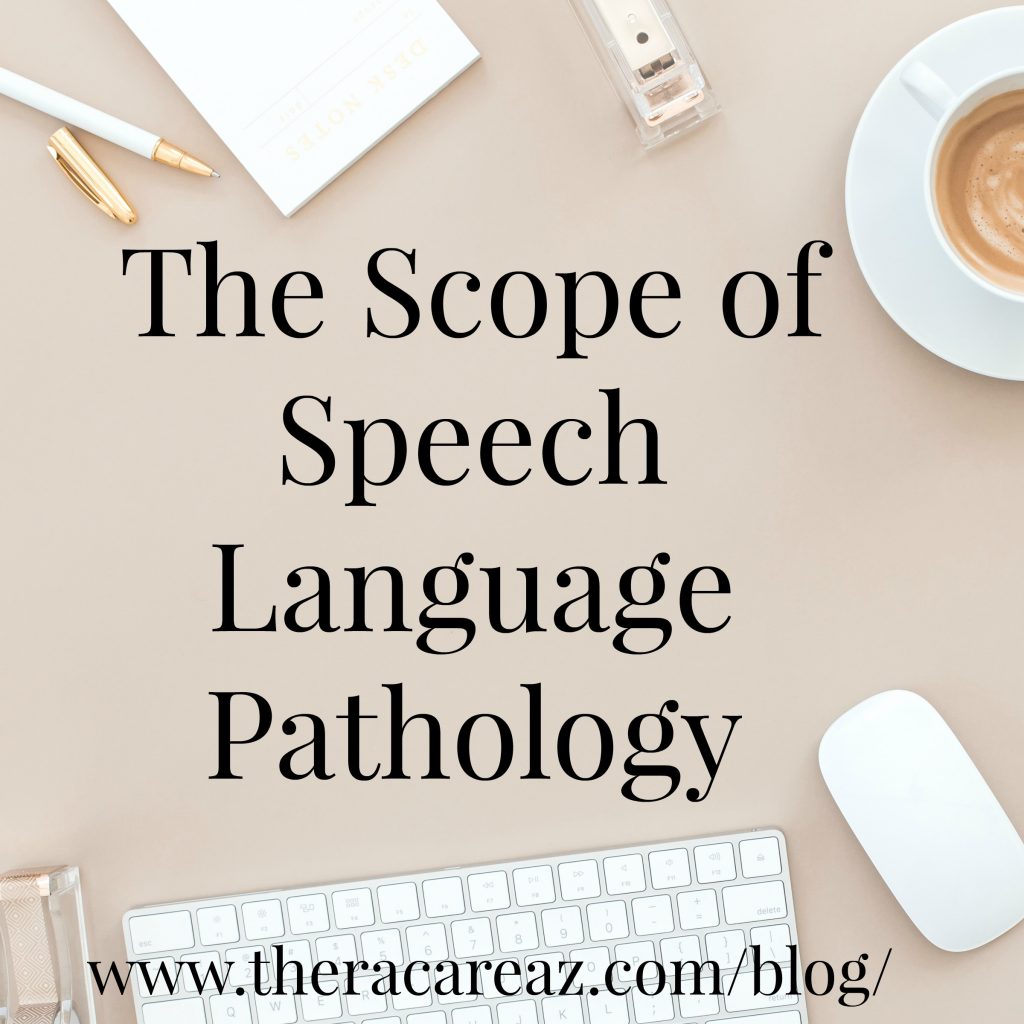
-
- When most people think of speech therapy, working on speech sounds is the first thing that usually comes to mind. We all either know of or experienced a “speech teacher” when we were in school ourselves; not knowing the “speech teacher” worked on a lot more than just speech! Speech-Language Pathologists (SLPs) can work in schools, hospitals, rehabilitation centers, skilled nursing facilities, private clinics, universities, and even provide home based services.According to the American Speech Hearing Association, the practice of Speech Pathology “continually evolves” and contains several domains of service delivery. I hope this list below helps you have a better understanding of all the many different areas in which an SLP may work on improving. This list does not include domains such as counseling, collaboration, education, research, or specific etiologies within the categories listed. Please refer to the ASHA updated scope of practice for a full and comprehensive list of what the profession of Speech Language Pathology entails.
Speech-Language Pathologists (SLPs) work on many different areas of communication and cognition, including but not limited to:
DIAGNOSTICS
Screenings and Evaluations: including but not limited to speech screenings, speech/language evaluations, and bedside swallowing evaluations (to determine a patient’s safest diet level). SLPs who work in hospitals may also perform endoscopy, videofluoroscopy, fiber-optic evaluation of swallowing (voice, velopharyngeal function, swallowing) and other instrumentation to assess aspects of voice, resonance, and swallowing.
SPEECH
Articulation: working on error speech sounds, such as /th/, /r/ and /s/
Phonology: working with whole sound classes that are being produced incorrectly, for example, a child is stopping (shortening) all of their “long” sounds (t/s, ch/sh, d/z)
Apraxia: Apraxia is the inability to coordinate the muscle movements for speech. The differentiation of apraxia versus a severe speech or phonological delay/disorder is determined when the SLP performs the initial speech/language evaluation. Speech sound errors, phonology errors, and apraxia are all different diagnoses, and all have a different plans of treatment that your SLP will choose to follow.
Oral Motor: working on improving any oral motor weakness or decreased range of motion that might interfere with speech sound production or the mechanics of eating (biting, chewing).
Augmentative Communication: Teaching children and /or adults how to communicate via a device, such as an Ipad which has a communication program app installed, Vanguard communication devices, or other.
Sign Language: Speech pathologists who work with deaf individuals or who work at Schools for the Deaf are fluent in sign. Speech therapists may also choose to teach ASL signs to hearing children prior to them being able to communicate verbally, in order to increase their current ability to communicate their needs and wants, and thereby decreasing their frustration while learning to communicate verbally.
Stuttering: When a client has speech blocks, or repeats sounds, words, or phrases, and this has been determined to not be due to normal childhood dysfluency and is more than 3% of their total speech production, then a therapist will work with the client to teach them smooth speech techniques. For children who stutter, it is important they receive therapy prior to the age of 8 to have the best chance for fluency.
LANGUAGE- Spoken and written language (listening, processing, speaking, reading, writing, pragmatics)
Prelinguistic: joint attention, intentionality, communicative signaling
Expressive language: Work to improve a client’s ability to express their needs and wants via speech, sign, or AAC. SLP’s also work with clients to improve their grammar, syntax, and semantics. Describing, story retell, and conversation skills are also worked on under expressive language.
Receptive language: SLPs work on this to help a client’s ability to understand what is being said to them. They work on improving a client’s ability to follow directions, answer questions, and understand main ideas in both written and spoken language.
Social/Pragmatic Langauge: SLP’s work on a client’s ability to understand the components of non verbal language (tone, body language, eye contact), in addition to turn taking (both in activities and in conversations), sportsmanship (being a good winner/loser), friendship skills (making and maintaining) understanding sarcasm, and the ability to participate in and maintain “small talk”. Therapists also work on helping clients understand and use figurative language (idioms, similes, metaphors, etc) appropriately.
FEEDING/DYSPHAGIA (In certain states, it is the Occupational Therapist who addresses these issues, and not the SLP).
Feeding: SLP’s work with clients who have a limited food reportoire (picky eaters) to help them expand their food choices and tolerances, including helping them overcome any sensory issues that are contributing to their limitations.
Swallowing: Children who had feeding tubes early on and adults/children who have had strokes can demonstrate difficulty with the process of forming a bolus (our food mixed with our saliva to form a cohesive “package” that we easily swallow), moving said bolus to the back of the oral cavity to trigger a swallow reflex, and swallowing appropriately (ability to protect our airway during swallowing so that the food goes down the esophagus and into the stomach and not down the trachea where it can end up in the lung and cause aspiration pneumonia.) The elderly and those who suffer from dementia, including Alzheimer’s are also at risk for needing this type of skilled speech therapy intervention. SLPs who work in medical settings who work with dysphagia clients will also perform bedside swallowing evaluations to help determine a patient’s safest diet and will work in conjunction with radiologists and doctors to assess modified barium swallow studies.
Cognition/Safety
Problem Solving : Therapists work with clients of all ages to help them effectively and safely problem solve (including being able to correctly gauge the size of a problem and determine danger within the environment)
Divergent/Convergent Thinking: The ability for the brain to be able to both list and categorize (organize) information
Sequencing: The ability to sequence steps of tasks, specifically life skills, in order to complete the skill and improve overall independence.
Other
Voice: Speech therapists work with both adults and children who are recovering from vocal surgery, rehab from vocal abuse (think little boys who yell all the time on the playground, then develop hoarseness due to vocal nodules), and people whose pitch is either too low (hyponasal) or too high (hypernasal).
Cleft Palate/Craniofacial: Clients who have had surgery to repair a cleft lip or palate often need speech therapy to help them make their speech sounds appropriately, specifically plosives (sounds where air is built up and then released, for example, /b/ and /p/) and speech sounds where nasal air emissions were previously present due to the cleft (/s/, /z/) or both /ch/.
Auditory Habilitation/Rehabilitation: Speech, language, communication, and listening skills impacted by hearing loss, or deafness. Auditory processing skills are also addressed by the SLP.
Play skills: Play is considered the building block foundation of language skills. Children who have limited play skills or do not play with toys appropriately (for example, line up their cars instead of moving them with a car noise) require intervention to expand their play skills. Often an SLP will work in improving vocabulary and ability to understand and follow directions into play goals.
Life Skills: Because so many life skills require the ability to categorize, sequence, and be safe, SLPs will work on life skills with their clients. This could be a teenager with autism who needs to learn how to fill out a job application, answer interview questions, do their own laundry, or follow a recipe. For an adult who has had a stroke, this can mean relearning how to do these things. By working with an SLP, the client who has had a stroke or head injury can, through speech therapy, teach a different part of the brain to “take over” these tasks from the part of the brain that has been hurt by the stroke or injury.
As all encompassing and vast as this list seems, there are still other things that are within an SLPs scope of practice, for example, a speech pathologist may choose to specialize in early intervention (working with clients age birth-3 yrs old), helping second language learners work on accent reduction, or specialize in children who need help getting rid of a tongue thrust. I hope this has given you a window into the world of being a Speech-Language Pathologist.

Katie Sulli
 van, M.S., SLP-CCC has been a pediatric Speech Language Pathologist for 23 years, and is a Therapy Supervisor with Theracare. She is the mother to five children, ages 8-18, including twin teenage sons with special needs. You can follow her at the My Sweet Homeschool blog, facebook, twitter, and instagram.
van, M.S., SLP-CCC has been a pediatric Speech Language Pathologist for 23 years, and is a Therapy Supervisor with Theracare. She is the mother to five children, ages 8-18, including twin teenage sons with special needs. You can follow her at the My Sweet Homeschool blog, facebook, twitter, and instagram.
- When most people think of speech therapy, working on speech sounds is the first thing that usually comes to mind. We all either know of or experienced a “speech teacher” when we were in school ourselves; not knowing the “speech teacher” worked on a lot more than just speech! Speech-Language Pathologists (SLPs) can work in schools, hospitals, rehabilitation centers, skilled nursing facilities, private clinics, universities, and even provide home based services.According to the American Speech Hearing Association, the practice of Speech Pathology “continually evolves” and contains several domains of service delivery. I hope this list below helps you have a better understanding of all the many different areas in which an SLP may work on improving. This list does not include domains such as counseling, collaboration, education, research, or specific etiologies within the categories listed. Please refer to the ASHA updated scope of practice for a full and comprehensive list of what the profession of Speech Language Pathology entails.





